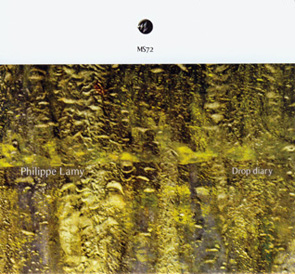 Daniel Crokaert’s Mystery Sea label challenges artists to produce music inspired by and infused with the mystique of "liquid states," whether that means using the sound of amplified water or catching the unpredictable flow of human perception on disc. French musician and painter Philippe Lamy comes at that challenge from both directions on Drop Diary, using the sound of water to focus on the way various environmental and synthetic sounds interconnect. Each piece is stacked with tiny sounds, but the way he weaves them all together gives the album a beautiful, supernatural quality, as open and as alive as the environments used to make it.
Daniel Crokaert’s Mystery Sea label challenges artists to produce music inspired by and infused with the mystique of "liquid states," whether that means using the sound of amplified water or catching the unpredictable flow of human perception on disc. French musician and painter Philippe Lamy comes at that challenge from both directions on Drop Diary, using the sound of water to focus on the way various environmental and synthetic sounds interconnect. Each piece is stacked with tiny sounds, but the way he weaves them all together gives the album a beautiful, supernatural quality, as open and as alive as the environments used to make it.
Lamy treats the sound of water like a constant in his otherwise stream-of- consciousness productions. In some instances it echoes nakedly, in others it drones on almost inaudibly, masked by waves of digital refuse and processed noise. But it’s always there. Philippe pours it into metal pans and glass cups. He captures its fall from branches and awnings during and after a storm, and he records its sibilant singing as it splashes and cuts down streams and over surfaces.
He combines these noises with other environmental and synthetic sounds, forcing his listeners to imagine each element as part of a larger web of events and motions. Those motions propel his music forward and reshape the rigid digital sounds into a less definite, more accommodating state. The crunch of broken glass mingles with a horse trotting down a brick road, which then rubs elbows with the sound of water trickling through pipes, which tumbles into a burst of digital noise before coming to rest in a still room, with a light storm passing by outside.
Lamy presumably took these sounds from places he knows well, and he uses the proximity of those places to arrange the music. He connects horse hooves to lawnmowers to throbbing, Badalamenti-esque synthesizers in a kind of four dimensional sound photo; not because there's a secret narrative running between them, but because these things exist side by side somewhere in France, where the album was recorded. That continuity calls into question whether the spaces Lamy recorded are distinct and individual locations at all, and not artificially determined segments of one uninterrupted space. Is it the sound that flows or does the flowing come from the consciousness that connects all the dots?
As the album progresses Philippe removes many of his sound sources. Instead of tumbling over one another, events start to come one and two at a time. Birds sing in the far distance, insects chirp and buzz with them, the sound of water echoes ever clearer. By the time it’s over, Lamy has slowed time down and reduced the music to an almost meditative hum. As the field recordings intermingle, an exciting sense of scope materializes; a feeling that the very smallest things in the world are all connected, and that something much bigger is waiting just over the horizon.
samples:
 
Read More

